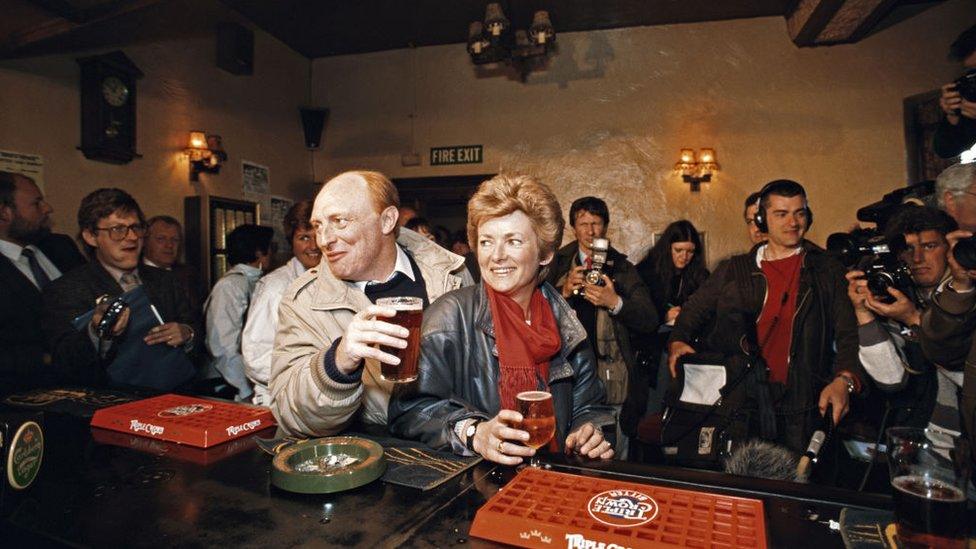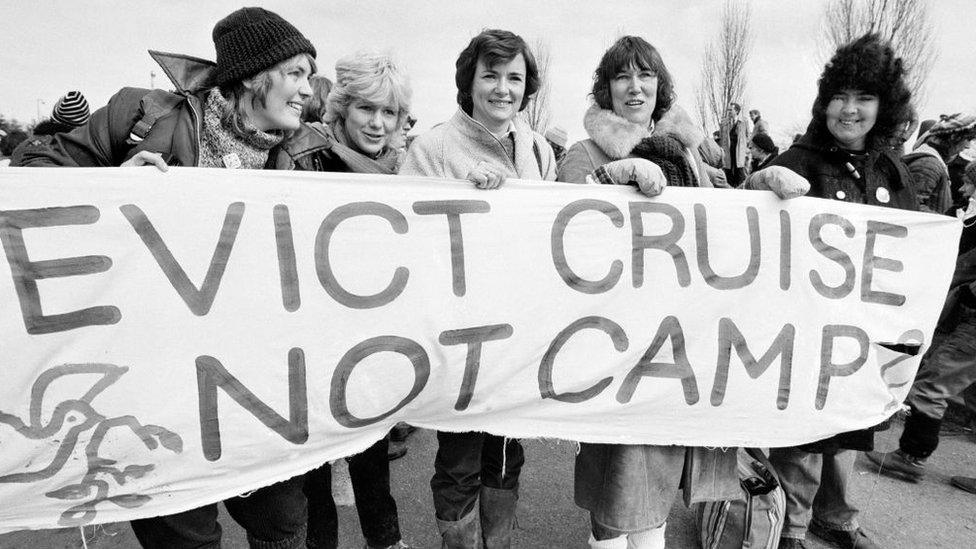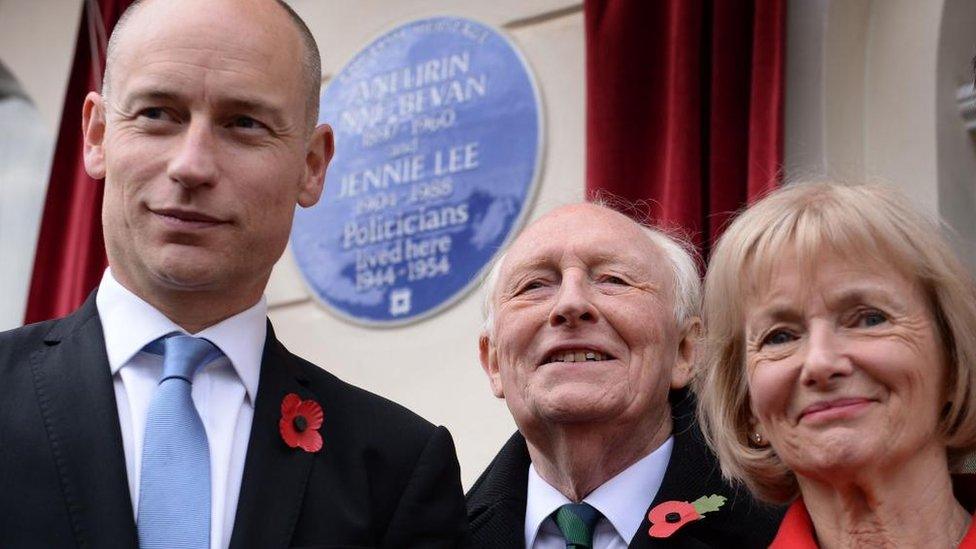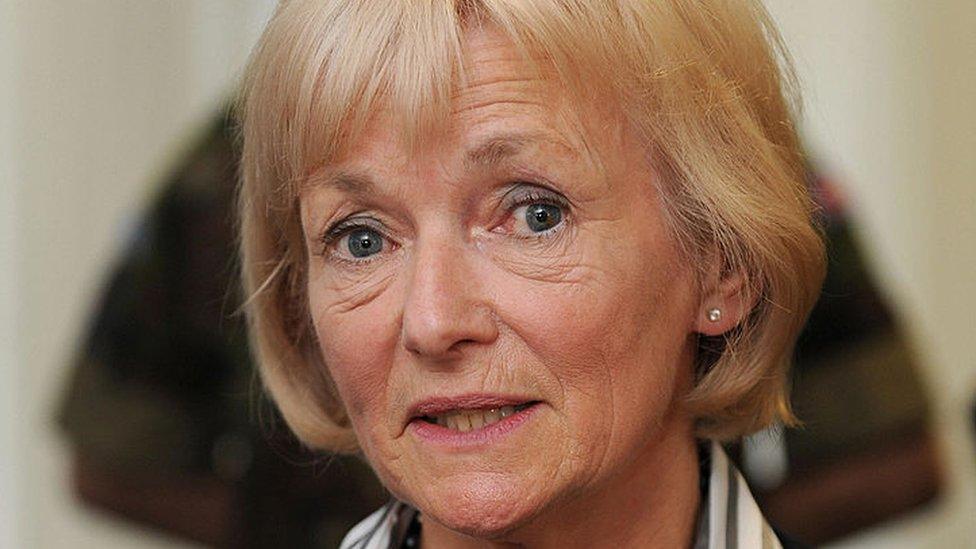Glenys Kinnock: The political spouse who became a force in her own right
- Published

Neil and Glenys Kinnock in a Pontllanfraith pub during the 1987 general election campaign
Glenys Kinnock, who has died aged 79, was the wife of the former Labour Party leader Neil Kinnock - and a prominent political figure in her own right.
She had a high profile during her husband's time leading the party through most of the 1980s and into the early 90s.
When he resigned after Labour's 1992 election defeat, she spent 15 years in the European Parliament and then a year as a UK government foreign minister in Gordon Brown's government.
As Baroness Kinnock of Holyhead, she sat in the Lords between 2009 and April 2021.
Born on 7 July 1944 as Glenys Elizabeth Parry, she grew up in a Welsh-speaking, chapel-going family on Anglesey.
Her father was a railway signalman, union official and former merchant seaman who claimed that her pram was crammed full of Labour literature during the campaign that led to Labour's 1945 landslide election victory.
Later telling the BBC the young Glenys had a strong sense of justice, she said her politics was a reaction to feeling that people were not getting their fair share.

Glenys Kinnock (centre) demonstrates against the deployment of nuclear cruise missiles at RAF Greenham Common near Newbury in Berkshire, December in 1983
Her Holyhead Comprehensive School report portrayed a "bright, mature and intelligent" pupil who went on to Cardiff University, studying education and history, where she met Neil Kinnock.
She said she remembered a "loud ginger person" in the lunch queue who offered her a leaflet and asked her for a date.
Speaking in 1988, he said: "She took my eye immediately, and has been taking it ever since."
"She's got all the qualities that make women superior in so many departments, of that there is no doubt," he added.
"I think probably [she has] a little gift as well, possibly something to do with coming from the Druids' country, Anglesey. I don't know what it is, a bit of second sight I guess."
Neil Kinnock was to become widely acknowledged as a great public speaker, but he admitted that as a student he made no contribution to the university debating society until "she turned up" and said she quite liked people debating.
"And I thought 'right, this is it, I can clinch the deal'", he said.
"So I made a speech, which apparently went down rather well, and from then on kept on doing it."
Neil and Glenys became husband and wife in 1967.

Glenys Kinnock, with her husband Lord Kinnock and their son, Stephen Kinnock MP, in 2015
Entering teaching after graduating, Glenys became a national UK figure when Neil won the Labour leadership in 1983.
She later said that Conservative-supporting newspapers had wrongly portrayed her as the power behind the throne, by suggesting she was more intelligent than her husband.
Politically active herself, she visited the women campaigning against the controversial deployment of nuclear cruise missiles at the Greenham Common American airbase in Berkshire in 1983.
She also attended miners' rallies during their year-long strike in the mid-eighties.
Neil Kinnock lost a second election as Labour leader in 1992 and quit the role.

The Kinnocks in 2014 arriving for a Labour function in London
Glenys Kinnock had a wide field of interests, but was especially well-known for her work to alleviate poverty and starvation in Africa and other parts of the world.
She became an MEP in 1994 and was a prominent member of several committees.
For a period, she was also Labour's spokeswoman on international development in the European Parliament.
Glenys Kinnock left the European Parliament in 2009, and days later was appointed minister for Europe by Prime Minister Gordon Brown.
When her husband was ennobled some years earlier, she was entitled to be called Lady Kinnock - but it was a title she never used.
However, on her appointment as minister for Europe, she became a peeress in her own right.
Announcing her death on Sunday, her family said she had "endured Alzheimer's" since a 2017 diagnosis and faced it with "innate courage".
She is survived by Neil, her husband of 56 years, who was with her in her final moments, and her children Stephen, Labour MP for Aberavon, and Rachel.
She was described in a family tribute as "an adored grandmother".

STEELTOWN MURDERS: Three murders - unsolved but never forgotten
UNMISSABLE DRAMA: When the Wolf is at the door, be very afraid

Related topics
- Published3 December 2023

- Published28 March 2022
